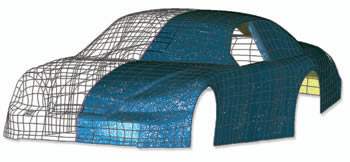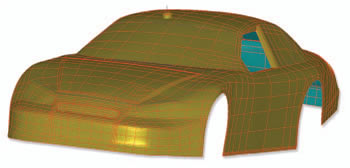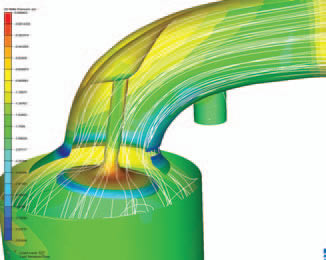Digital Tools Make A Winner
How digital shape sampling and CFD bring racing cars to the finish line faster.
Latest News
July 2, 2007
By Bob Cramblitt
As the wins and top-10 finishes accumulated during the 2006 NASCAR Nextel Cup and Busch Series season for Richard Childress Racing (RCR) teams, theories abounded about what was fueling their Chevrolets. But by the time Kevin Harvick won the season-opening Daytona 500 in February of 2007, the engineers at the RCR complex in Welcome, NC, were experts at applying reverse engineering and computational fluid dynamics (CFD) to key car elements week by week to help gas up results.
 A point cloud typically containing four to six million points is brought into Geomagic Studio software for decimation and processing. |
Merging Technology and Talent
The lead engineers in the RCR renaissance, Chad Zimmer and Noah McKay, know how to translate research results into on-track performance in two very separate but equally important aspects to racing cars. Zimmer is extending RCR’s work in automated cylinder head porting and CFD simulation to improve horsepower for the team’s engines. McKay is heading up a program that combines scanning, meshing, modeling, and CFD to capture race car bodies and digitally test car aerodynamics under realistic racing conditions. At the center of this work is software from Geomagic, Inc. (Research Triangle Park, NC) to help the pair ensure consistent performance week after week.
Geomagic Studio is Geomagic’s reverse engineering solution, which enables digital shape sampling and processing (DSSP), and helps ensure accurate CFD and FEA results. DSSP refers to the use of technologies that enable creating exact digital duplications of custom-made parts for engineering analysis and rapid manufacturing.
RCR began using DSSP technology for cylinder head porting around 2000. Traditionally, craftsmen would hand-grind the ports in cylinder heads to deliver the most effective fuel-and-air mixture to the cylinder, customizing them for different types of tracks and racing conditions. The labor-intensive hand grinding would typically take 40 hours for each cylinder head. There were few efficiency gains in grinding subsequent cylinder heads, and it was often difficult to replicate the work done on a particularly well-performing head.
 It typically takes about 20 different scans to capture an entire car shell. After processing the point cloud,Geomagic Studio optimizes patch layout to increase the accuracy of the surface model. |
Geomagic Studio, however, enabled RCR to scan a hand-ported head and automatically transform point-cloud data into an accurate surface model in about six hours. Once the first model is created, subsequent ones can be duplicated in minutes. The high-fidelity models give RCR the ability to accurately recreate the porting in a high-performance cylinder head over and over again with consistent results.
The process still begins with hand-grinding. The head is then tested on a flow bench to determine efficiency, and if it passes muster, it is ready for digital duplication.
Capturing complex geometry
Over the past year, RCR has speeded data capture and increased its accuracy by using a combination of a CMM touch probe — a Renishaw SP600 system — and a laser scanner. The SP600 is good at capturing precise throat shapes, and collecting data from deep, narrow passages within the cylinder head. The laser scanner makes quick work of capturing all other data in the form of point clouds.
Because of its complexity, it takes as many as several hundred laser scans to capture data for a complete cylinder head. The scans are brought into Geomagic Studio, where they are registered automatically. The software allows RCR to quickly and easily fill holes and smooth surfaces. Surface reconstruction time is reduced substantially by the patented Geomagic feature of “wrapping” point-cloud data to automatically generate a polygon surface. Polygon models can be converted into accurate NURBS surfaces with one click of a mouse or by user-defined layout for interactive surface editing.
RCR creates templates in Geomagic Studio for surface models of ports and chambers, enabling engineers to mix and match port shapes from past designs and tailor them to the specifications for the current project.
In parallel with processing of laser-scan data, data from the touch probe is brought into Pro/Engineer, where the points are lofted to create surfaces. The resulting model is imported into Geomagic Studio, where patches are created, imperfections removed, and surfaces smoothed. The models generated from the laser and probe data are blended to create a composite surface model.
More knowledge — less time
The completed model is sent back to Pro/Engineer, where final processing is done for CFD. From there, the model can take two paths: CFdesign might be used for a quick evaluation of flow trends or it is meshed in Fluent’s GAMBIT and sent on to FLUENT CFD for more detailed studies of flow characteristics.
“The digital tools we have allow us to try more ideas and get the results of changes quicker,” says Zimmer. “We gain more knowledge in less time.”
Based on CFD results, changes are made in Pro/Engineer and the design is tested again or finalized for machining in RCR’s dedicated cylinder head shop.
“The increased quality of the surfaces is showing up in a lower scrap rate when cutting cylinder heads and more accurate throat positioning, which reduces rework,” says Zimmer. “When we dyno engines to compare hand-ground ports with those duplicated by Geomagic, they perform identically.”
Customizing aerodynamics
While Zimmer is concentrating on maximizing flow within cylinder heads, his colleague McKay is taking on the challenge of refining the aerodynamic efficiency of RCR’s car bodies. As with almost everything else in stock-car racing, a “one-size-fits-all” approach just won’t do.
 The final NURBS surface model created by Geomagic Studio software. Combining an ATOS scanner with Geomagic has helped cut the time it takes to surface a car from a week and a half to a few days. |
“The aerodynamics change from week to week, so car bodies have to be customized,” says McKay. For example, he says that at Bristol, TN, the track is short yet it has the highest banks of any track on the Nextel Cup circuit. In this environment, the focus is on balancing the flow force on the front tires, with less concern about down force. In contrast, the very next week the race shifts to Michigan; a faster track with moderately banked curves and long straight-aways. The emphasis here is on achieving the asymmetry to push the car to the inside of the curve and generating down force for greater stability.
While there was a considerable amount of guesswork on how body designs would respond to specific tracks in the past, aerodynamics can be much more accurately predicted thanks to the combination of DSSP and CFD.
RCR starts by sending an outer shell frame to Penske Technology Group (PTG) about an hour up the road in Mooresville, NC. Ideally, the car body will arrive in gray primer that can be scanned directly, but sometimes it will come to Penske complete with decals, in which case engineers apply a thin coat of powder to reduce reflectivity.
PTG has a dedicated scanning bay, with reference plates on the floor that can be aligned with their counterparts on the car. Scanning is done with a GOM ATOS white-light scanner from Capture3D that projects a pattern onto an object’s surface. The pattern is captured by cameras positioned on each side of the scanner’s sensor head. Scanning a shell frame of a car takes about five to six hours. Because of the importance of asymmetry in the body design, PTG can’t take the typical short cut of scanning half of the car and mirroring it within Geomagic software; the entire car needs to be scanned.
It typically takes about 20 different scans to capture a car shell. The scans are converged within ATOS software into one large point cloud containing four to six million points, then brought into Geomagic Studio for decimation and processing. Despite the size differences in the objects, the automated procedures for transforming the car shell model from point cloud to polygons and to NURBS surfaces are similar to those used for modeling laser data from cylinder heads. Depending on the level of detail required, the Geomagic work takes between a day and a half and two days.
“We can have a car shell delivered to us on Wednesday morning and prepare a complete CAD model by Friday evening,” says John Moloney, general manager of PTG. “The advances in scanning systems, Geomagic software, and processing power have helped us cut the time it takes to surface a Cup car from about a week and a half to two or three days.”
Determining the “why factor”
After receiving the Pro/E model from PTG, McKay adds the necessary components to complete the model, including the frame underneath, the engine and duct work, and other parts of the assembly. Depending on how many newly designed parts are needed, this could take anywhere from a few days to a few weeks.
 Richard Childress Racing uses CFdesign software from Blue Ridge Numerics to assess flow trends based on digitally reconstructed cylinder head ports. |
When the full car body is modeled, the data is sent in IGES format to Corvid Technologies, another Mooresville company that specializes in CFD, shock physics, and structural mechanics analysis. Unlike other companies that limit the use of CFD for analyzing a design that is already set, Corvid uses CFD as an interactive development tool.
“We use CFD to diagnose changes at the component level and drive development,” says Jimmy Carpenter, Corvid’s director of CFD. “In a wind tunnel, you don’t know why something occurs; the power of CFD is that it reveals the why factor.”
Corvid uses Rhino software to clean up the CAD model for meshing, ICEM to generate the mesh, and its own RavenCFD software for solving large-scale problems at the cell level. The major advantage of RavenCFD is that it is scalable to thousands of processors in a Linux cluster; Corvid typically runs CFD problems containing 30 to 40 million cells on its 440-processor cluster.
The aerodynamics in the details
CFD testing at Corvid is done as an iterative process: a change is made to a component and then a simulation is run to compare the effects of the change on internal and external wind flow for the car body. The process continues until desired results are reached in each component being tested. Postprocessing tools within RavenCFD analyze the results, after which they are presented to RCR as PowerPoint presentations.
“The process has reduced test time in wind tunnels and helped us select paths that reap rewards,” says McKay. “We can test more design configurations and learn more about details that yield benefits.” Those details can include the composition of parts and panels, the optimum height of exterior components, and the positions of components relative to one another.
“Using our current methods, we’ve improved down-force generation by 13.5 percent, results which we’ve been able to validate in wind-tunnel testing,” says McKay. Since down force is one of the most important areas of aerodynamic efficiency in stock car racing, this substantial improvement translates into major performance gains on the track.
A winning combination
Harvick drove away with the Busch Series championship and placed third in the overall NASCAR Nextel Cup standings last year. Jeff Burton, the pilot of another RCR team, placed seventh overall, winning a Nextel Cup race and two Busch races, while Clint Bowyer, a rookie RCR driver, placed 17th overall.
Without diminishing the impact of great drivers, personnel, pit crews, and good fortune, perhaps it’s time to give the combination of great technology and smart engineers its due as a major part of a winning formula. After all, a car generating more engine power and achieving better aerodynamics will deliver a distinct competitive advantage to its driver and team.
“The racing results speak for themselves,” says McKay.
Capture3D
Costa Mesa, CA
capture3d.com
CFdesign
Blue Ridge Numerics
Charlottesville, VA
cfdesign.com
Corvid Technologies
Mooresville, NC
corvidtechnologies.com
GAMBIT, FLUENT CFD
Fluent, Inc.
Lebanon, NH
fluent.us
Geomagic Studio
Geomagic, Inc.
Research Triangle Park, NC
geomagic.com
ICEM Ltd.
Southfield, MI
icem.com
Pro/Engineer
PTC
Needham, MA
ptc.com
RavenCFD
Mooresville, NC
ravencfd.com
Renishaw
Gloucestershire, UK
renishaw.com
Richard Childress Racing
Welcome, NC
rcrracing.com
Rhinoceros
Robert McNeel & Associates
Seattle, WA
mcneel.com
Bob Cramblitt owns Cramblitt & Company in Cary, NC, and writes about design, engineering, and IT technologies. Send him an e-mail about this article to [email protected].
Subscribe to our FREE magazine, FREE email newsletters or both!
Latest News
About the Author
DE’s editors contribute news and new product announcements to Digital Engineering.
Press releases may be sent to them via [email protected].






